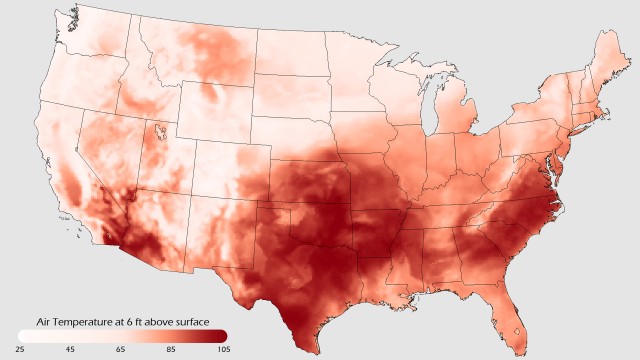 |
| The drought and heat wave of 2011, an example of an extreme event. |
When you see a lot of sixes coming up on a friend’s Monopoly dice, you might begin to harbor a suspicion that the dice are loaded. But if you see sevens appear, you know something is definitely amiss.
Many scientists have used the analogy of loaded dice when they talk about how weather extremes would change in a warming climate, where the loading of the dice would become apparent over time. So, were recent extreme events like the suffocating 2010 Moscow heat wave or the 2011 Texas drought the product of loaded climate dice?
The immediate cause of each was a meteorological event, such as the “blocking high” that kept the hot weather over Moscow for so long. However, a new study led by NASA’s James Hansen argues that “we can say with high confidence that such extreme anomalies would not have occurred in the absence of global warming.” These basic meteorological events are not uncommon, the study says, but the extreme aspects were made possible by the underlying climate.
The conclusion comes from an analysis of how climate variability has changed since the 1950s. The analysis focuses on the Northern Hemisphere summer months of June, July, and August. This is partly because the winter season is inherently more variable (which makes it harder to detect changes), and partly because longer and warmer summers lead to the kind of extreme droughts and heat waves that have major impacts. (The Northern Hemisphere summer also covers a much larger land mass, where seasonal swings are large, than does the Southern Hemisphere summer.)
The relatively steady climate from 1951 to 1980 is used as the baseline for comparison; since then, the climate has warmed nearly 0.6°C (1.1°F). Over that time, temperatures fell pretty nicely along a bell curve. Extreme warm (or cool) summer weather, lying more than three standard deviations away from the average, were present over less than one percent of the globe at any given time. Moving toward the present, however, the analysis shows the bell curve becoming a bit wider and shifting toward warmer temperatures, meaning that three-standard-deviation warmth now occurs over roughly ten percent of the globe.
The open access paper is unusual in that it is clearly written to be understandable to the general public, and is obviously aimed at them. Hansen used his membership in the National Academies of Science to publish the paper, and accompanied its release with an op-ed in the Washington Post.
The paper also makes an appeal to personal experience, suggesting that, while year-to-year variability makes it difficult for people to personally relate to global warming, “a perceptive person old enough to remember the climate of 1951-1980 should recognize the existence of climate change, especially in summer.” The authors also point out that their analysis involves no climate models, and they include material that clearly anticipates objections from those who distrust climate science.
The potential for a broadening of the climate bell curve, leading to more frequent extremes, has been a topic of discussion for some time. This study purports to provide evidence that this is, indeed, already occurring, though some valid concerns about the methods have been raised. If the analysis proves accurate, the implications for the future are obvious. “Additional global warming in the next 50 [years], if business-as-usual fossil fuel emissions continue,” the authors write, “is expected to be at least 1°C. In that case, the further shifting of the anomaly distribution will make [three-standard-deviation] anomalies the norm and [five-standard-deviation] anomalies will be common.” A climate that rolls more sevens-or eights-is an uncomfortable reality to face.
PNAS, 2012. DOI: 10.1073/pnas.1205276109 (Open Access) (About DOIs).


